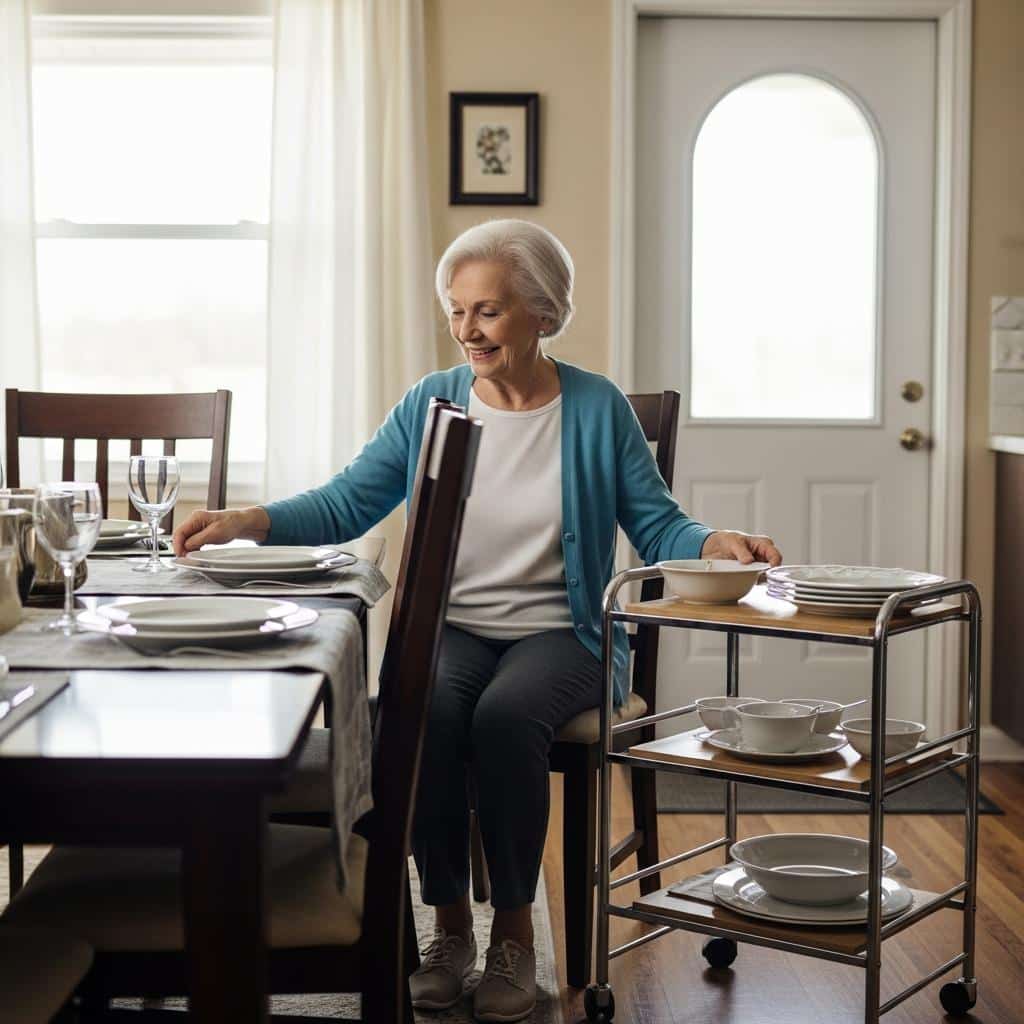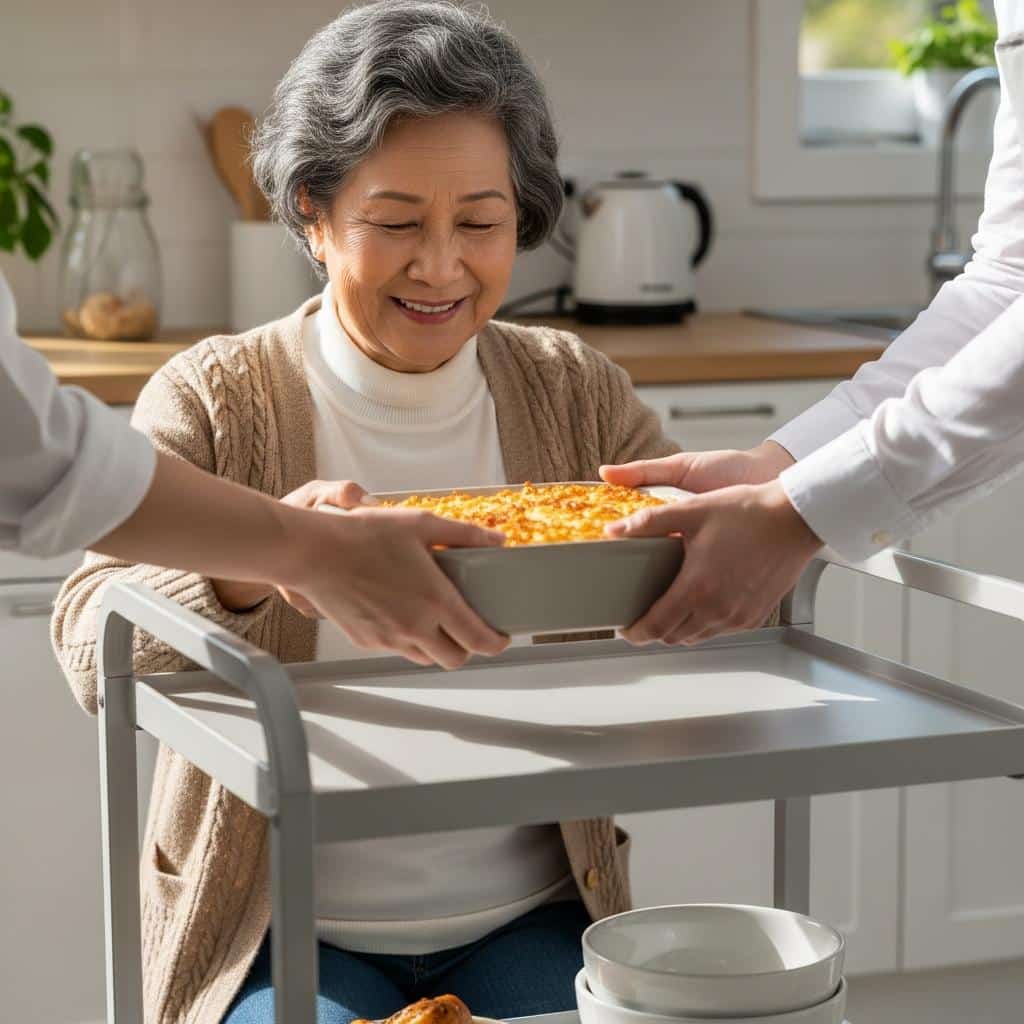Picture this: It’s Thanksgiving morning, and you’re already imagining the warm hugs, the laughter around the table, and your family’s faces when they see the spread you’ve prepared.
But then reality hits—the thought of lifting that heavy roaster, bending to arrange place settings, or making endless trips from kitchen to table.
Sound familiar?
Here’s the thing: You don’t have to choose between hosting the Thanksgiving you love and protecting your body. The secret isn’t doing less—it’s doing it smarter.
What if I told you that a few strategic setup decisions could transform your Thanksgiving from exhausting to enjoyable?
That you could be the gracious, capable host you’ve always been, just with a few clever adjustments that your guests will never even notice?

Rethink Your Table Geography Before Anyone Arrives
The biggest mistake most hosts make? Setting up their dining room the same way they always have, without considering how much unnecessary movement they’re creating for themselves.
Position Yourself for Success
Your chair placement matters more than you think. Place your seat no more than three feet from the kitchen entrance. This isn’t about accommodating limitations—it’s about efficiency. Why walk an extra dozen steps every time you need to grab something?
If you use a walker or cane, create a traffic pattern that gives you a clear, obstacle-free path. Move that side table now, before guests arrive and it becomes awkward to rearrange. This is part of the broader fall prevention strategy that keeps you safe throughout your home.
Put Heavy Items Within Arm’s Reach
Here’s a game-changing strategy: Position the turkey and heaviest serving dishes directly in front of your seat. Not at the center of the table where tradition says they should go, but where you can reach them without standing, leaning, or risking a spill.
Lighter items—rolls, butter, cranberry sauce—can go at the far end for guests to pass. You’re orchestrating the meal, and conductors don’t have to touch every instrument.
Create Your Pre-Staging Zone
Set up a small side table or rolling cart within arm’s reach of your chair. This becomes your “landing zone” for dishes coming from the kitchen. You can bring items to this spot, then transfer them to the table when you’re ready—no balancing acts required.
Think of it as a pit stop in a race. Strategic, efficient, and frankly, just smart hosting.

The Lazy Susan Strategy That Changes Everything
Want to know the single tool that can transform your entire Thanksgiving experience? A lazy Susan.
Why This Simple Tool Is a Hosting Game-Changer
A lazy Susan eliminates the need for you to pass dishes, reach across the table, or stand repeatedly to retrieve items. Guests simply spin it to access what they need. It’s communal, elegant, and secretly brilliant for hosts who want to minimize physical strain.
Look for one that’s at least 18 inches in diameter for a proper Thanksgiving spread. Wood or bamboo options are sturdy and won’t slide around. If your table is long, consider using two—one at each end.
Present It Like the Upgrade It Is
Some people worry that using a lazy Susan seems too casual or suggests they “can’t handle it.” Flip that narrative. When guests arrive, say something like: “I’m trying something new this year so we can all stay seated and actually enjoy our meal together while everything’s hot!”
See what you did there? You just positioned a practical solution as a thoughtful hosting choice. Because it is.
Ready to discover more innovative strategies for healthy, comfortable aging? Subscribe to our newsletter for expert-tested tips and product recommendations designed specifically for older adults.

The Buffet vs. Family-Style Decision You Need to Make
Let’s address the question many hosts wrestle with: Should you set up a buffet or do traditional family-style serving?
Why Buffet-Style Often Makes the Most Sense
A well-organized buffet transfers the physical work to your guests—and they don’t mind one bit. People actually enjoy building their own plates and controlling their portions.
It’s not “giving up” on hosting; it’s modern, efficient, and allows you to sit down and eat with everyone instead of playing server.
Set up your buffet on a counter or sturdy table at a comfortable height. Arrange items in logical order: plates first, then turkey, sides, and finally silverware and napkins at the end.
How to Create Traffic Flow That Works
Here’s what most people get wrong: They create a buffet that requires guests to backtrack or crowd together. Map out a one-way flow that moves people smoothly from empty plate to full plate to their seat. Mark the starting point clearly with the dinner plates.
If you’re worried about guests creating obstacles while you’re moving around, designate a specific “staging time” when everyone serves themselves at once, then the path stays clear.
The Seated Family-Style Compromise
If buffet feels too informal for your family’s traditions, there’s a middle ground. Use family-style serving, but position yourself strategically so heavy dishes are within your reach, and lighter items are placed where guests can pass them among themselves.
You can still feel like the traditional host while minimizing the physical demands. It’s all in the setup.

Your 48-Hour Prep Timeline That Saves Your Energy
The secret to a pain-free Thanksgiving isn’t just how you set up the table—it’s how you pace yourself in the days leading up to it.
Two Days Before: The Physical Setup
This is when you do all the furniture moving, table arranging, and organizing of serving pieces. Take your time, ask for help if needed, and give yourself permission to rest between tasks. There’s no medal for doing it all in one exhausting session.
Set out your serving dishes, utensils, and anything you’ll need on Thanksgiving Day. Label them if it helps. The goal is to eliminate decision-making and searching when you’re already tired.
One Day Before: The Seated Prep Work
Wednesday is for food prep you can do while sitting: chopping vegetables, making casseroles, prepping ingredients. Set up a comfortable workspace at your kitchen table with everything within reach. There’s no rule that says you have to stand at the counter. If chopping and meal prep cause hand discomfort, ergonomic kitchen tools designed for arthritic hands can make this work significantly easier.
Assemble dishes that can be refrigerated and simply popped in the oven Thursday morning. Your Thanksgiving Day self will thank Wednesday you.
Thanksgiving Morning: Minimal and Mindful
If you’ve done your prep work, Thursday morning should be about finishing touches only. Hot dishes that must be fresh, last-minute garnishes, and that’s it. Most of your work is already complete.
Build in rest periods. Set a timer if you need to, but commit to sitting down every 20-30 minutes. This isn’t optional—it’s strategic energy management for a host who wants to actually enjoy the day.
The Post-Meal Plan You Need Now
Before guests arrive, decide on your cleanup strategy. Will you do it later? Will family help? Are you using disposable containers for leftovers to minimize dishwashing? Make these decisions when you’re fresh, not exhausted.
Give yourself permission to use disposables if it means you have energy left for conversation. The food tastes the same whether it’s on china or compostable plates.

Smart Solutions for Kitchen-to-Table Transport
Let’s talk about the moment that makes many hosts nervous: getting hot, heavy dishes from the kitchen to the table safely.
The Rolling Cart Revolution
A rolling cart is the single best investment you can make for hosting safely. Not a walker, not a “medical device”—just a smart kitchen tool that chefs and caterers use because it’s efficient. You can transport multiple dishes in one trip, and you never have to carry weight while walking. If you’re also looking to reduce strain during meal prep, consider investing in lightweight cookware designed for easier handling.
Look for one with sturdy wheels, a flat surface, and ideally a lower shelf for extra capacity. Position it near the stove on Thanksgiving morning, and load it up when dishes are ready.
When and How to Ask for Help
Here’s a script that preserves your dignity while getting the support you need: “Would you mind carrying this dish to the table? It’s heavy and I don’t want to risk spilling it on anyone.”
See what you did? You made it about protecting your guests, not about your limitations. It’s not weakness to delegate—it’s smart logistics.
Serve Direct from the Source
Not every dish needs to make it to the dining room table. Some items can stay in the kitchen where guests serve themselves at the buffet, or you can bring dishes to the table after everyone is seated and you’ve had a moment to rest.
Turkey can be carved in the kitchen, plated, and brought out on a single large platter. Gravy can stay warm on the stove and be brought to the table in a thermal carafe.
Managing Your Energy and Your Expectations
Here’s the truth that needs to be said: The perfect Thanksgiving exists only in magazines, and those tables took a crew of stylists six hours to arrange.
Permission to Modify Traditions
Your family comes to see you, not to inspect your turkey’s golden ratio or judge whether your rolls are homemade. If store-bought sides give you two extra hours of energy to spend with your grandchildren, that’s a trade worth making.
Traditions can evolve. The core of Thanksgiving—gratitude, togetherness, good food—remains whether you make the stuffing from scratch or heat it from a box.
Reading Your Body’s Signals
If you’re tired, sit down. If your back hurts, ask for help. If you need to end the gathering earlier than usual, that’s okay. Taking care of yourself isn’t selfish—it means you’ll be able to host many more Thanksgivings to come.
You don’t need to push through pain to prove you’re capable. Capable people know when to rest.
The Art of Ending Gracefully
Have a closing script ready: “I’ve absolutely loved having you all here. I’m going to wind down for the evening now, but please take leftovers before you go!” Say it warmly, with a smile, and no one will question it.
You’ve given them a beautiful meal and your time. That’s more than enough.
Looking for more ways to maintain your independence while adapting to life’s changes? Join our newsletter for practical tips delivered right to your inbox.
Quick Wins That Make a Big Difference
Before we wrap up, here are a few bonus strategies you can implement right now:
Pre-pour drinks and store them in the fridge so guests can grab their own. This eliminates dozens of small requests throughout the day. If you’re setting up serving pieces on higher shelves, a stable step stool designed for seniors can help you reach items safely during prep.
Use name cards strategically to control your seating arrangement. Put yourself where you need to be, and position helpers near you if you want backup.
Set up a kids’ station if young children are coming. A separate low table keeps them out of the main traffic pattern and reduces chaos in your space.
Prep a rest space where you can retreat for 10-minute breaks. A quiet bedroom with a chair and maybe a glass of water. Use it.
Have a backup plan. Keep the number of a good local restaurant on speed dial, or have a frozen lasagna in the freezer just in case. You’ll probably never need it, but knowing it’s there reduces anxiety.
You’re Going to Host a Beautiful Thanksgiving
Here’s what I want you to remember: Your family doesn’t need perfection. They need you.
They need your stories, your laughter, your presence at the table. They’ll remember the warmth of the gathering long after they’ve forgotten whether the gravy was lumpy. Looking for more ways to create meaningful moments with family that don’t exhaust you?
Check out our guide to low-energy fall activities with grandchildren that prioritize connection over perfection.
By setting up your table strategically, pacing yourself, and giving yourself permission to host in a way that honors both tradition and your physical reality, you’re not compromising—you’re modeling wisdom. You’re showing your family that taking care of yourself isn’t weakness; it’s what allows you to keep doing the things you love.
Start with just two or three of these strategies this year. See what works. Adjust as needed. And most importantly, sit down at that table with your family and soak in the gratitude of another Thanksgiving together.
You’ve got this. And your back? It’s going to thank you.
What’s one strategy from this list that you’re excited to try this Thanksgiving? Or do you have a hosting hack of your own to share? We’d love to hear from you in the comments below!

![Older couple setting up buffet kitchen counter[1]](https://www.grayingwithgrace.com/wp-content/uploads/2025/11/older_couple_setting_up_buffet_kitchen_counter1-e1762873850753.jpg)










![Senior group autumn walk cane[1]](https://www.grayingwithgrace.com/wp-content/uploads/2025/11/senior_group_autumn_walk_cane1-e1762875262861-450x300.jpg)
![Asian grandfather granddaughter arranging potluck[1]](https://www.grayingwithgrace.com/wp-content/uploads/2025/11/asian_grandfather_granddaughter_arranging_potluck1-e1762874989504-450x300.jpg)
![Older woman with cane cooking with son[1]](https://www.grayingwithgrace.com/wp-content/uploads/2025/11/older_woman_with_cane_cooking_with_son1-e1762874788231-450x300.jpg)
![Elderly woman resting couch morning light[1]](https://www.grayingwithgrace.com/wp-content/uploads/2025/11/elderly_woman_resting_couch_morning_light1-e1762874558330-450x300.jpg)
![Elderly man with walker watching grandchild dessert[1]](https://www.grayingwithgrace.com/wp-content/uploads/2025/11/elderly_man_with_walker_watching_grandchild_dessert1-e1762874265659-450x300.jpg)
![Grandfather autumn puzzle daylight[1]](https://www.grayingwithgrace.com/wp-content/uploads/2025/10/grandfather_autumn_puzzle_daylight1-e1761043151497-450x300.jpg)
![Older asian man journaling alarm clock[1]](https://www.grayingwithgrace.com/wp-content/uploads/2025/10/older_asian_man_journaling_alarm_clock1-e1761042239318-450x300.jpg)
![Hispanic man greek yogurt pumpkin mousse kitchen[1]](https://www.grayingwithgrace.com/wp-content/uploads/2025/10/hispanic_man_greek_yogurt_pumpkin_mousse_kitchen1-1-450x300.jpg)



